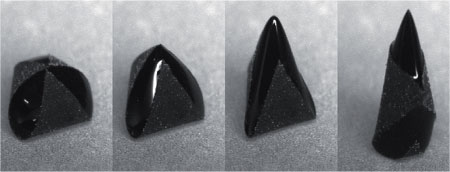Magnetic Field Flips Miniature Origami
In the technique known as capillary origami, the surface tension of a drop of liquid folds a small flexible membrane into a desired shape. Researchers reporting in Physical Review Letters augment the technique with a new trick: By using a fluid that is susceptible to magnetic forces, they can actively control the shape of the folded object as it forms. They also discovered an unexpected instability in which the membrane switches abruptly from one shape to another. The method could be used in the future to control the shape of a micromechanical component during the operation of a device.
In the original demonstration of capillary origami (see video from 11 April 2007 Focus story), surface tension caused a thin membrane cut into a flowerlike pattern to wrap itself around a drop of water placed upon it, creating a boxlike structure. For a given membrane pattern and water drop size, elementary physics determined the three-dimensional structure produced.
Timothée Jamin, Charlotte Py, and Eric Falcon, of the French National Center for Scientific Research (CNRS) and Paris Diderot University, have now worked a variation on this method by substituting a so-called ferrofluid for the drop of water. In their experiments, the ferrofluid was a suspension in water of nanometer-sized particles of maghemite ( ). Placed in a vertical magnetic field of steadily increasing strength, a globule of this ferrofluid grew taller, going from a roughly spherical shape into a conical form with the vertex at the top, and finally into an object resembling a bullet standing on end.
In a series of tests, the researchers placed single drops of the ferrofluid onto membranes of a rubbery material (polydimethylsiloxane) that was between and thick and cut into equilateral triangles to on a side. In each case, in the absence of a magnetic field, the triangle curled up around the droplet, so that its corners met. As before, applying a magnetic field distended the ferrofluid drop, but with the membrane clinging to its sides, the drop grew into an approximately triangular pyramid whose height increased with the strength of the field.
However, the surface tension between the membrane and the ferrofluid prevented the fluid pyramid from growing as high as it would on its own. As the magnetic field strength grew and the pyramid tried to become taller and narrower, it became harder for the membrane to wrap around it in a smooth way. At a critical value of the field strength, the system suddenly resolved by flipping into a new configuration. The base of the pyramid switched from the center of the triangular membrane toward one of its corners, and it transformed into a taller circular cone, rebalancing the magnetic and gravitational forces. At the same time, the membrane climbed higher up the cone and wrapped around it in a new configuration.
“This is a fascinating twist on the capillary origami story—as the ferrofluid tries to elongate vertically out of the clutches of its pyramidal wrapper, the wrapper suddenly slips itself around into a new lower-stress shape,” says Glen McHale of Nottingham Trent University in England.
The critical magnetic field strength for this “overturning” instability depends on the size of the fluid drop and membrane, the authors found. The method lends itself to miniaturization, Falcon says, because the required field strengths would be lower for smaller origami systems. “It thus could provide a useful tool for making D microstructure shapes and for dynamically changing their shapes by means of a magnetic field.”
McHale notes that practical applications of the technique may be complicated by the fact that the instability is not reversible—that is, when the magnetic field is decreased, the membrane folds over into a different shape than the one it had at the start. Still, he says, “I love the experiment.”
–David Lindley
David Lindley is a freelance science writer in Alexandria, Virginia.
More Information
Micro-origami (Focus story from 2007)





